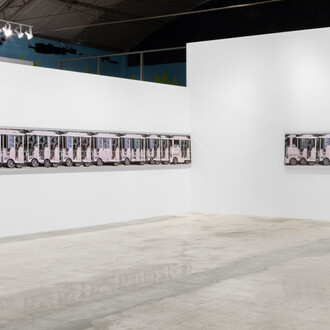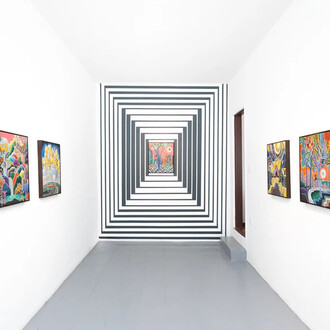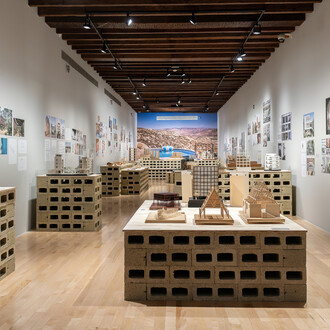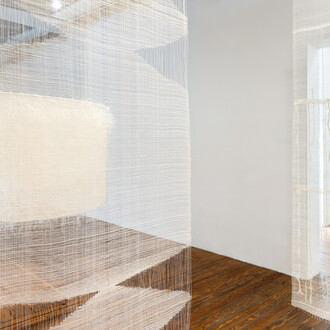In Shared breath, Beatriz Cortez and Fidencio Fifield-Perez present explorations of migration across landscapes, times, and places. Using woven paper, acrylic paint, and welded steel, they each articulate how identity and self are shaped by personal movement across great distances, and how the land and its ecology move through us in ways both imperceptibly slow and undeniably real. Their practices provide divergent yet interconnected perspectives of migration as a natural and metaphysical process beyond economic or political realities.
For Fifield-Perez, migration poses a question of rootedness. In paintings like The garden (2023), he depicts his lived experience through objects packed in a U-haul moving truck. Charting a cross-country move through the United States, the truck's front is dense with essentials. Yet, what the viewer predominantly sees are plants—gifts from friends and family. Their care and movement across the country represent a connective rhizome at the heart of the self, even when transient. In contrast, woven paper reflects restrictive boundaries in Some strange rain (2021). The grid, long associated with modernity's fixation on control and rationality, serves as both a representation of bureaucratic documentation and a deconstructive tool challenging notions of structure and regulation. Superimposed are plants, evoking living, breathing, and growing amidst restrictive systems.
Cortez’s work centers on similar themes, though with an inverted temporality. Rather than focusing on individual migration, Cortez considers it on a geological, almost cosmological scale. Her new ongoing body of work, Migrante (2024-), consists of welded whale bones—animals for whom migration is the core of their lives. Through steel, these bones connect our present day to the deep time of geological history. Whales have existed for millions of years, outliving the very oceans in which they once swam. Like a seashell, Migrante (ear bone) has an acoustic resonance effect which gives the impression that one hears this ancient ocean, transporting the viewer to a past where these bones may have once lived. The presence of their bones on dry land reflects a geological truth that much of Earth’s land was once ocean. Continental drift, radical ecological shifts, and even human actions on climate produce a landscape that moves through people, rather than an anthropocentric view in which humans move through land.
Both Fifield-Perez and Cortez share the experience of having uprooted their lives to move thousands of miles to the United States. While their work stems from this shared reality, they explore migration beyond individual or human boundaries. Fifield-Perez’s plants, like in Wet willow (2022) or previous projects like Dacaments have been grown, traveled, grafted, and maintained, experiencing time not unlike people. Cortez frequently explores this theme of time, as seen in previous works like Nomad 13, a futuristic garden filled with ancient plants. The steel bones in Migrante similarly function as temporal markers of collective human memory, evoking unnamed and unmarked bodies lost in landscapes during migration. Together, Cortez and Fifield-Perez peel away the metaphors, political structures, and economic pressures of global migration, revealing the essence of what it means to journey and transform.
Beatriz Cortez (b. 1970, San Salvador; lives and works in Los Angeles and Davis) received an MFA from California Institute of the Arts (2015) and a PhD in Latin American Literature from Arizona State University (1999). Solo exhibitions have been held at Storm King Art Center, New Windsor (2023); Williams College Museum of Art, Williamstown (2023); Commonwealth and Council, Los Angeles (2022); Pitzer College Art Galleries, Claremont (2022); Institute of Contemporary Art, San Diego (2021); Craft Contemporary, Los Angeles (2019); Occidental College, Los Angeles (2019); Clockshop, Los Angeles (2018); and Vincent Price Art Museum, Monterey Park (2016). Selected group exhibitions have been held at Manetti Shrem Museum of Art, Davis (2024); Montalvo Arts Center, Saratoga (2024); 60th Venice Biennale (2024); Tufts University Art Galleries, Medford (2022); Los Angeles Contemporary Exhibitions (2021, 2016); Michigan State University Broad Art Museum, East Lansing (2021); Museo de Arte Contemporáneo, Panama (2021); 18th Street Arts Center, Santa Monica (2020); Wattis Institute for Contemporary Arts, San Francisco (2020); Henry Art Gallery, Seattle (2019); Museo de Arte Moderno de Bogotá (2019); TEOR/éTica, San José (2019); Ballroom Marfa (2019); Socrates Sculpture Park, New York (2019); John Michael Kohler Arts Center, Sheboygan (2018); Hammer Museum, Los Angeles (2018); and Whitney Museum of American Art, New York (2017). Cortez is a recipient of Latinx Arts Fellowship, Mellon Foundation (2023), New School Vera List Center Borderlands Fellowship (2022-24), Artadia Los Angeles Award (2020), Rema Hort Mann Foundation Emerging Artist Grant (2018), Artist Community Engagement Grant (2017), and California Community Foundation Fellowship for Visual Artists (2016). Cortez has participated in residencies at Atelier Calder, Saché (2022); California Studio Manetti Shrem, University of California, Davis (2022); and Longenecker-Roth, San Diego (2021).
Cortez’s work is in the collections of El Paso Museum of Art; Ford Foundation, New York; Institute of Contemporary Art, San Diego; Lawrence University, Appleton; Los Angeles County Museum of Art; Michigan State University Broad Art Museum, East Lansing; Museo Comunitario Kaqjay, Patzicía; and Museo de la Imagen y la Palabra, San Salvador.
Fidencio Fifield-Perez (b. 1990, Oaxaca; lives and works in Davis) received an MFA from University of Iowa (2015) and a BFA from Memphis College of Art (2013). Selected solo exhibitions have been held at Highpoint Center for Printmaking, Minneapolis (2023); Vanderbilt University Fine Arts Gallery, Nashville (2021); Quincy Art Center (2022); Craft Alliance Center of Art + Design, St. Louis (2019). Selected group exhibitions have been held at Galveston Artist Residency (2023); Cleveland Museum of Art (2020); International Print Center New York (2020); The Luminary, St. Louis (2019); Nerman Museum of Contemporary Art, Overland Park (2019); and Museum of Contemporary Photography, Chicago (2019). Fifield-Perez has participated in residencies at Crosstown Arts, Memphis (2022); Oak Spring Garden Foundation, Upperville (2021); Salina Art Center (2020); Ox-Bow, Saugatuck (2019); and The Studios at MASS MoCA, North Adams (2019).
Fifield-Perez’s work is in the collections of Bernard A. Zuckerman Museum of Art, Kennesaw; Cleveland Museum of Art; Minia University, Cairo; Le Bonheur, Memphis; and University Galleries of Illinois State University, Normal.












